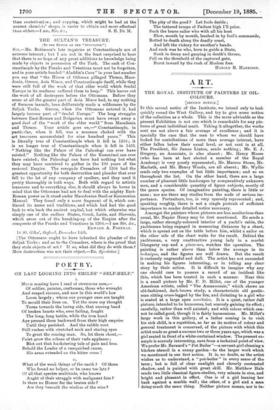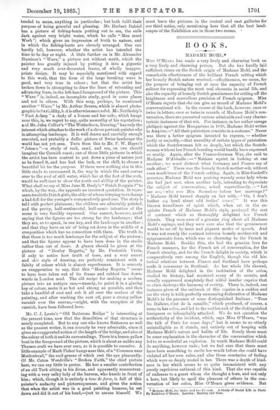ART.
THE ROYAL INSTITUTE OF PAINTERS IN OIL- COLOURS.
[SECOND NOTICE.]
Ix this second notice of the Institute, we intend only to look quickly round the West Gallery, and try to give some notion of the collection as a whole. This is the more advisable as the present Exhibition is not one which is remarkable for any pic- tures of great individual merit. Taking it altogether, the works sent are not above a fair average of excellence ; and it is- specially the case that the men to whom we should have looked for contributions of more than average interest, have either fallen below their usual level, or not sent in at all. The President, Sir James Linton, sends nothing ; Mr. E. J. Gregory, an Associate, is also absent ; Mr. Henry Moore (who has been at last elected a member of the Royal Academy) is very poorly represented ; Mr. Marcus Stone, Mr. Macbeth, and Mr. Henry Woods, are all absent ; Mr. Wyllie- sends only two examples of but little importance ; and so on throughout the list. On the other hand, there are a large number of pleasant little landscapes by comparatively unknown men, and a considerable quantity of figure subjects, mostly of the genre species. Of imaginative painting, there is little or none ; nor are there any studies from the nude of serious im- portance. Portraiture, too, is very sparsely represented ; and, speaking roughly, there is not a single portrait of sufficient importance to render detailed notice necessary.
Amongst the painters whose pictures are less meritorious than usual, Mr. Napier Hemy may be first mentioned. He sends a large, rather strongly-coloured interior of a yacht's cabin, the- yachtsman being engaged in measuring distances by a chart, which is spread out on the table before him, whilst a sailor on the other side of the chart waits for the result. Behind the yachtsman, a very unattractive young lady in a scarlet Glengarry cap and a pince-nez, watches the operation. The painting is rather above than below the average in its and the figures are well drawn. But the result is curiously ungraceful and dull. The artist has not succeeded in making his figures interesting, or in telling any clear story by their action. It is difficult to imagine why any one should care to possess a record of an incident like this, which has been treated in such a manner. Near this is a small picture by Mr. F. D. Millet, one of the younger American artists, called " The Amanuensis," which shows an old-fashioned, dark-brown study, a characteristic old gentle- man sitting cross-legged by the fire, and dictating to a girl who- is seated at a large open secretaire. It is a quiet, rather dull picture, intended to be humorous, but scarcely gaining its effect ; carefully, rather than well painted; and with colour which can- not be called good, though it is fairly harmonious. Mr. Millet's large work in this gallery, of a father coming in to visit his sick child, is a repetition, as far as its motive of colour and general treatment is concerned, of the picture with which this artist made so great a success two or three years ago, which was a girl seated in front of a white-curtained window. The present ex- ample is scarcely interesting, save from a technical point of view- We prefer Mr. Barnard's "Pot Boiler "—a servant-girl cleaning a kitchen utensil in a sunny garden—to the larger work which we mentioned in our first notice. It is, no doubt, as the artist wishes us to understand, a " pot-boiler " in every sense of the term ; but is full of clear sunlight and cleverly contrasted shadow, and is painted with great skill. Mr. Matthew Hale sends two little classical figure-studies, very minute in size, and bright and pleasant in effect. One is of a girl leaning her back against a marble wall; the other, of a girl and a man doing much the same thing. Neither picture means, nor is in- tended to mean, anything in particular ; but both fulfil their purpose of being graceful and pleasing. Mr. Herbert Dalziel has a picture of fishing-boats putting out to sea, the sails dark against very bright water, which he calls " Men must Work "; which gives an impression of truth to nature, and in which the fishing-boats are cleverly arranged. One can hardly tell, however, whether the artist has intended the time to be day or night. A little further on is Mr. Alexander Harrison's " Wave," a picture not without merit, which the painter has greatly injured by putting it into a gigantic and very much over-decorated frame, of wholly inappro- priate design. It may ba especially mentioned with regard to this work, that the form of the large breaking wave is good, and very true in colour ; but that the artist has broken down in attempting to draw the lines of retreating and advancing foam, in the left-hand foreground of the picture. This " Wave " is, indeed, an incomplete study, good in some places and not in others. With this may, perhaps, be mentioned another " Wave," by Mr. Arthur Severn, which is almost photo- graphic in ifsrioidity,b.itis otherwise successful. Mr.Nettleship's " Fast Asleep " a study of a lioness and her cubs, which hangs near this, is, we regret to say, quite unworthy of his reputation; and Mr. John Collier's "The Wetterhorn, Evening," has only the interest which attaches to the work of a clever portrait-painter who is,attempting landscape. It is well drawn and carefully enough executed, and probably a duller picture of Swiss landscape the world has not yet seen. Turn from this to Mr. F. W. Hayes's "Jetsam "—a study of rock, sand, and sea, on (we should imagine) the Cornish coast; one of those little pictures in which the artist has been content to put down a piece of nature jest as he found it, and has had the luck, or the skill, to choose a beautiful bit for the purpose. If there were nothing else in this little study to recommend it, the way in which the sand curves over to the pool of still water, which lies at the foot of the rock, would be sufficient to show the truth and ability of the painter. What shall we say of Miss Jane M. Dealy's " Dutch Bargain ?" to which, by the way, she appends an incorrect quotation. It repre- sents twolittle D utch girls, the elder of whom is trying to exchange abad. doll for the younger's comparatively good one. The story is toll with perfect plainness ; the children are admirably painted, and the pretty, half-sentimental, half-comic intention of the scene is very forcibly expressed. One cannot, however, avoid saying that the figures are top strong for the landscape ; that they are, so to speak, in one key, and the landscape in another ; and that they have an air of being set down in the middle of a composition which has no connection with them. The truth is, that there is too much landscape for the subject of the picture ; and that the figures appear to have been done in the studio rather than out of doors. A glance should be given at the picture of " Henley Regatta," by Mr. Frederick Vezin, if only to notice how truth of tone, and a very smart and chic style of drawing, are perfectly consistent with a falsity of colour which is almost superhuman. It is scarcely an exaggeration to say, that this "Henley Regatta " seems to have been taken out of its frame and rubbed face down- wards in London mud. The old recipe for making a modern picture into an antique one,—namely, to paint it in a glaring key of colour, make it as hot and strong as possible, and then take a handful of soot and rub it all over the surface of the painting, and after washing the soot off, pour a strong yellow varnish over the canvas,—might, with the exception of the varnish, have been followed here.
Mr. C. J. Lewis's " Old Battersea Bridge " is interesting at the present time, now that the demolition of that structure is nearly completed. But to any one who knows Battersea as well as the present writer, it can scarcely be very admirable, since it gives an exaggerated notion of the length of the bridge, and also of the colour of both it and its surroundings. There is a lemon-yellow boat in the foreground of the picture, which is about as unlike any Thames craft we have ever seen, as it is possible to conceive. A little example of Mark Fisher hangs near this, of a "Common near Maidenhead," the cool greens of which rest the eye pleasantly. Of Mr. Caton Woodville's " Broken Faith," the chief picture here, we can say little in praise. He has a smaller contribution of an old Turk sitting in his divan, and apparently remonstrat- ing with a very sulky lady of the hareem, who kneels in front of him; which, though it is entirely a tour de force, is fall of this painter's audacity and picturesqueness, and gives the notion that when the artist was in a good painting humour, he sat down and did it out of his head,—just to amuse himself. We must leave the pictures in the central and east galleries for our third notice, only mentioning here that all the best land- scapes of the Exhibition are in those two rooms. •











































 Previous page
Previous page